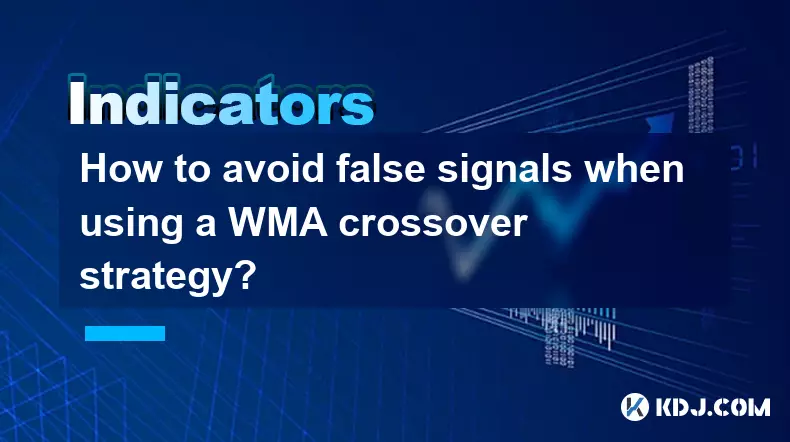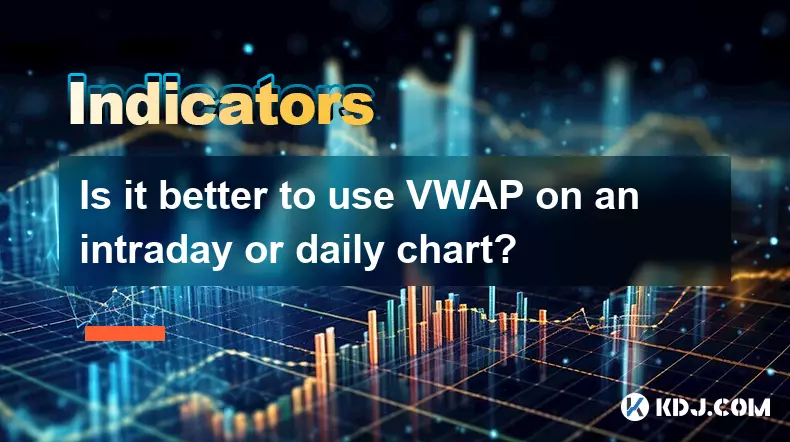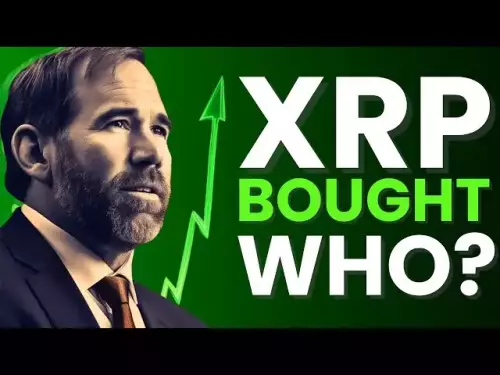-
 bitcoin
bitcoin $108842.957301 USD
-1.88% -
 ethereum
ethereum $3931.777121 USD
-1.66% -
 tether
tether $1.000186 USD
-0.03% -
 bnb
bnb $1153.250882 USD
-2.20% -
 xrp
xrp $2.367904 USD
-1.94% -
 solana
solana $186.182050 USD
-4.20% -
 usd-coin
usd-coin $0.999997 USD
0.00% -
 tron
tron $0.316949 USD
-1.00% -
 dogecoin
dogecoin $0.190780 USD
-3.12% -
 cardano
cardano $0.651324 USD
-2.67% -
 hyperliquid
hyperliquid $37.141055 USD
-0.85% -
 ethena-usde
ethena-usde $0.999224 USD
-0.09% -
 chainlink
chainlink $17.579031 USD
-2.47% -
 bitcoin-cash
bitcoin-cash $509.426284 USD
-2.79% -
 stellar
stellar $0.315298 USD
-2.93%
How to avoid false signals when using a WMA crossover strategy?
A WMA crossover signals potential trend changes, but combining it with volume analysis, multi-timeframe confirmation, and momentum indicators improves accuracy and reduces false entries.
Oct 15, 2025 at 06:54 pm

Understanding the WMA Crossover Mechanism
1. The Weighted Moving Average (WMA) assigns greater importance to recent price data, making it more responsive to new information compared to simple moving averages. This sensitivity can lead to quicker signal generation but also increases the risk of false triggers during volatile or sideways market conditions.
2. A WMA crossover occurs when a shorter-term WMA crosses above or below a longer-term WMA, suggesting potential trend changes. Traders often interpret a bullish crossover as a buy signal and a bearish one as a sell signal. However, these signals are not always reliable on their own.
3. False signals emerge when the price briefly moves in one direction, triggering the crossover, only to reverse shortly after. These whipsaws are common in ranging markets where there is no clear directional momentum.
4. To minimize noise, traders should evaluate the broader context of the crossover, including overall market structure, volume patterns, and alignment with higher timeframes. Signals that align with dominant trends tend to have higher accuracy.
5. Using multiple timeframes to confirm crossovers helps filter out misleading entries, especially when lower timeframe signals contradict the direction seen on daily or weekly charts.
Integrating Volume Analysis for Confirmation
1. Volume serves as a critical validator of any technical signal. A WMA crossover accompanied by a significant increase in trading volume suggests stronger market participation and conviction behind the move.
2. When a crossover happens on low volume, it may indicate lack of interest or manipulation by short-term traders, increasing the likelihood of a false breakout. Monitoring volume spikes helps distinguish genuine shifts from temporary fluctuations.
3. On-chain metrics for cryptocurrencies—such as exchange inflows/outflows or large transaction counts—can supplement traditional volume analysis, offering deeper insight into institutional or whale activity influencing price.
4. A rising volume profile concurrent with a WMA crossover enhances the reliability of the signal, reducing exposure to deceptive market movements.
5. Tools like Volume-Weighted Average Price (VWAP) or On-Balance Volume (OBV) can be plotted alongside WMA lines to provide additional layers of confirmation before executing trades.
Combining Filters and Additional Indicators
1. Applying volatility filters such as Bollinger Bands or Average True Range (ATR) helps identify periods of high uncertainty where WMA crossovers are more prone to failure. During low volatility, price movements may lack sustainability even if crossovers occur.
2. Incorporating momentum oscillators like the Relative Strength Index (RSI) or MACD allows traders to assess whether the asset is overbought or oversold at the point of crossover, adding another dimension of validation.
3. For instance, a bullish WMA crossover occurring while RSI is above 70 might suggest an overextended rally rather than a sustainable uptrend, warranting caution instead of immediate entry.
4. Multi-indicator confluence significantly reduces false positives; requiring alignment between WMA crossovers, momentum indicators, and volatility thresholds improves decision-making precision.
5. Some traders use candlestick patterns—such as engulfing bars or pin bars—at the moment of crossover to add price action confirmation, further strengthening the trade setup.
Frequently Asked Questions
What timeframes work best with WMA crossovers in crypto trading?The effectiveness of WMA crossovers varies by asset and market cycle. Many traders combine a 9-period and 21-period WMA on the 4-hour chart for swing trading, while scalpers may use 5 and 13 on 15-minute intervals. Testing combinations against historical data helps determine optimal settings.
Can WMA crossovers be used in bear markets?Yes, but with adjusted expectations. In downtrends, bearish crossovers tend to be more reliable than bullish ones. Long positions triggered by bullish crossovers often fail unless supported by strong reversal patterns or fundamental catalysts.
How does WMA differ from EMA in generating signals?While both emphasize recent prices, WMA applies linear weighting, giving the most recent data the highest multiplier. EMA uses exponential smoothing, which reacts faster than WMA in some cases. Backtesting shows WMA produces fewer but potentially higher-quality signals due to its smoother curve.
Is it advisable to automate WMA crossover strategies?Automation can execute entries quickly, but unmonitored bots may accumulate losses during choppy conditions. Adding conditional logic—like minimum volume thresholds or trend filters—improves performance. Regular review of automated systems remains essential in dynamic crypto markets.
Disclaimer:info@kdj.com
The information provided is not trading advice. kdj.com does not assume any responsibility for any investments made based on the information provided in this article. Cryptocurrencies are highly volatile and it is highly recommended that you invest with caution after thorough research!
If you believe that the content used on this website infringes your copyright, please contact us immediately (info@kdj.com) and we will delete it promptly.
- Crypto Coins with 100x Potential: Is Blazpay Presale the Real Deal?
- 2025-10-17 12:25:13
- Strike Gold in the Digital Age: Exploring Global Gold and the On-Chain Gold Ecosystem
- 2025-10-17 12:25:13
- US Government, Bitcoin Seizure, and the Chen Zhi Scam: A NYC Perspective
- 2025-10-17 12:45:17
- MAS, Tokenised Liabilities, and Stablecoins: A Singaporean Symphony
- 2025-10-17 12:30:08
- Solana, Dogecoin, and the Crypto Dip: Bargain Hunting or Dodging Bullets?
- 2025-10-17 10:45:16
- Gold, Bitcoin, and Investment: Navigating the Digital Frontier in Style
- 2025-10-17 10:25:15
Related knowledge

What's the main difference between VWAP and TWAP?
Oct 12,2025 at 11:54am
Understanding VWAP and Its Role in Crypto Trading1. Volume Weighted Average Price (VWAP) is a trading benchmark that calculates the average price of a...

How do you identify exhaustion moves using VWAP and its bands?
Oct 12,2025 at 08:00am
Understanding the Role of Decentralized Exchanges in Crypto Trading1. Decentralized exchanges (DEXs) operate without a central authority, allowing use...

Is it better to use VWAP on an intraday or daily chart?
Oct 15,2025 at 02:01am
Intraday Trading and the Role of VWAP1. Intraday traders frequently rely on VWAP (Volume Weighted Average Price) as a dynamic benchmark for assessing ...

How do you use VWAP to scale in and out of positions?
Oct 14,2025 at 02:19am
Understanding VWAP as a Dynamic Benchmark1. The Volume Weighted Average Price (VWAP) is not just an indicator—it functions as a dynamic benchmark that...

What are the main advantages of using VWAP over EMA?
Oct 11,2025 at 02:18am
Main Advantages of Using VWAP Over EMA1. Volume-Weighted Average Price (VWAP) incorporates trading volume into its calculation, offering a more accura...

How do you use VWAP on different chart types like Heikin Ashi?
Oct 11,2025 at 05:01pm
Understanding VWAP in the Context of Heikin Ashi Charts1. The Volume Weighted Average Price (VWAP) is a powerful analytical tool commonly used by trad...

What's the main difference between VWAP and TWAP?
Oct 12,2025 at 11:54am
Understanding VWAP and Its Role in Crypto Trading1. Volume Weighted Average Price (VWAP) is a trading benchmark that calculates the average price of a...

How do you identify exhaustion moves using VWAP and its bands?
Oct 12,2025 at 08:00am
Understanding the Role of Decentralized Exchanges in Crypto Trading1. Decentralized exchanges (DEXs) operate without a central authority, allowing use...

Is it better to use VWAP on an intraday or daily chart?
Oct 15,2025 at 02:01am
Intraday Trading and the Role of VWAP1. Intraday traders frequently rely on VWAP (Volume Weighted Average Price) as a dynamic benchmark for assessing ...

How do you use VWAP to scale in and out of positions?
Oct 14,2025 at 02:19am
Understanding VWAP as a Dynamic Benchmark1. The Volume Weighted Average Price (VWAP) is not just an indicator—it functions as a dynamic benchmark that...

What are the main advantages of using VWAP over EMA?
Oct 11,2025 at 02:18am
Main Advantages of Using VWAP Over EMA1. Volume-Weighted Average Price (VWAP) incorporates trading volume into its calculation, offering a more accura...

How do you use VWAP on different chart types like Heikin Ashi?
Oct 11,2025 at 05:01pm
Understanding VWAP in the Context of Heikin Ashi Charts1. The Volume Weighted Average Price (VWAP) is a powerful analytical tool commonly used by trad...
See all articles










































































